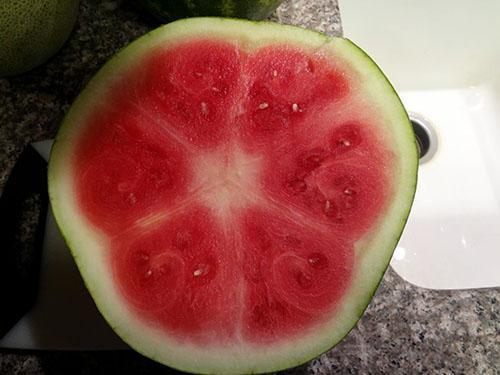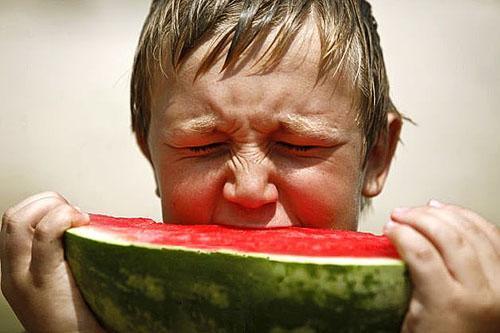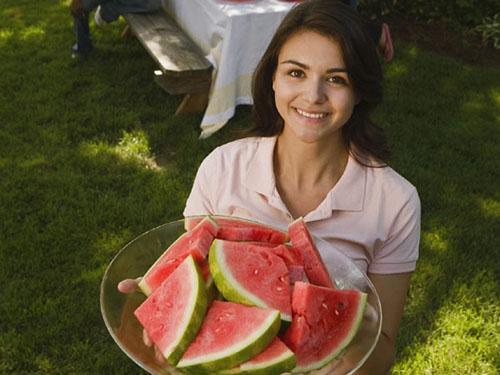What do the yellow and white streaks in the watermelon pulp mean?
 Knowing the popular love for watermelons, every year there are always people who are trying to make money on this, using dishonest or completely illegal methods. Most of these techniques are aimed at obtaining the earliest and most plentiful harvest. As a result, traders and agricultural producers benefit twice as:
Knowing the popular love for watermelons, every year there are always people who are trying to make money on this, using dishonest or completely illegal methods. Most of these techniques are aimed at obtaining the earliest and most plentiful harvest. As a result, traders and agricultural producers benefit twice as:
- they manage to sell watermelons when the bulk of the crop is still ripening in the beds;
- receiving additional profit from artificially gained weight of fruits.
The only one who loses is an unfortunate consumer who succumbed to temptation and bought a completely useless, far from always tasty, and sometimes very dangerous watermelon. Indeed, in pursuit of profit, unscrupulous melon growers, and then merchants, have to violate agricultural practices, flood the planting with chemicals, use seeds of dubious quality, and also, not observing the terms and conditions of storage of fruits, offer deliberately spoiled watermelons.

- rough yellow and white streaks in the watermelon;
- undeveloped areas of the pulp and cracks dividing it into several parts;
- sluggish, loose flesh inside the watermelon;
- uneven color;
- signs of fermentation.
And sometimes red sugar watermelon, instead of being sweet, tastes desperately bitter. Why is this happening? What to do with such a watermelon and what do the white and yellow streaks in the pulp mean?
Where are the white and yellow streaks in the watermelon from?
The main and most common cause of watermelon poisoning is the use of excess nitrogen fertilizers in the cultivation.
 Under normal conditions nitrogen - this is an indispensable element for the growth and development of plants, however, using it in excess of the permissible norms, melon growers can get a fruit weighing up to 10 kg in 2–3 weeks. After abundant watering and fertilizing with a solution of saltpeter, watermelons swell like by leaps and bounds, and instead of the prescribed 70–90 days of staying on a melon under the sun, they are harvested almost a month earlier. The producer receives an early harvest of huge fruits, but each of them has already managed to accumulate a hefty portion of nitrates, toxic to humans.
Under normal conditions nitrogen - this is an indispensable element for the growth and development of plants, however, using it in excess of the permissible norms, melon growers can get a fruit weighing up to 10 kg in 2–3 weeks. After abundant watering and fertilizing with a solution of saltpeter, watermelons swell like by leaps and bounds, and instead of the prescribed 70–90 days of staying on a melon under the sun, they are harvested almost a month earlier. The producer receives an early harvest of huge fruits, but each of them has already managed to accumulate a hefty portion of nitrates, toxic to humans.
One of the signs of "poisoning" of melons with nitrate are white and yellow streaks in the watermelon that pierce the flesh. They are formed due to the action of a chemical, forcing not only the whips to develop faster, but also the fetus. At first, these peculiar vessels are white and supply the still unripe watermelon with food, but under the influence of nitrates, the fruit grows rapidly and just as quickly ages. Therefore, the white veins in the watermelon soon coarsen and acquire a yellow or brownish tint.
 High doses of nitrates and nitrites synthesized from them in the body can accumulate and increase the negative effect. Exposure to nitrogen compounds affects the digestive system, disrupts metabolic processes and has a depressing effect on the nervous system. As a result of the ingestion of nitrites, the supply of oxygen to the tissues deteriorates, the immune system is destroyed.
High doses of nitrates and nitrites synthesized from them in the body can accumulate and increase the negative effect. Exposure to nitrogen compounds affects the digestive system, disrupts metabolic processes and has a depressing effect on the nervous system. As a result of the ingestion of nitrites, the supply of oxygen to the tissues deteriorates, the immune system is destroyed.
If an adult tolerates a dose of 150-200 mg relatively painlessly, then 600 mg of nitrates cause irreparable damage.But nitrogen compounds cause the greatest damage to young children, for whom a dose of 10 mg is toxic.
Why does a watermelon have loose flesh inside?
 Interestingly, the nitrate-induced process continues after such a "chemical" crop has been harvested. True, the watermelon no longer grows, but the tissues inside it change. Even torn off green, it soon turns red, and the white vessels gradually turn yellow. And a couple of weeks after harvesting, the flesh inside the watermelon is loose, crumbling and less juicy.
Interestingly, the nitrate-induced process continues after such a "chemical" crop has been harvested. True, the watermelon no longer grows, but the tissues inside it change. Even torn off green, it soon turns red, and the white vessels gradually turn yellow. And a couple of weeks after harvesting, the flesh inside the watermelon is loose, crumbling and less juicy.
When cutting a fruit pumped with nitrates, which has lain a little on the counter, in addition to yellow veins in a watermelon, areas of yellow compacted pulp are often found, reaching from 2 to 50 mm in diameter. The use of such a watermelon in healthy people can cause the most unpleasant consequences, and more precisely it will not bring pleasure. Using nitrates - this is the most common reason for the poor quality of melons, but in reality you can encounter some more unpleasant moments.
Asking the question: "Why is the watermelon inside loose and not tasty at all?", The buyer may come across a fruit that has been stored incorrectly for a long time. A couple of weeks in the scorching sun is enough for a watermelon torn from the whip to begin to lose moisture, and its pulp takes on the appearance of dry reddish or whitish grains. Typically, this process begins at the location of the seeds and then spreads to the core.
Why is watermelon bitter?
If coarse fibers in the pulp, changes in its color and structure, indicating the poor quality of the watermelon, are easy to see as soon as it is cut, then the bitter fruit will definitely have to be tasted at least once.
 Why is the watermelon famous for its sweetness bitter? There are several possible answers here. Most often, buyers have to deal with already lying fruits, which, due to natural reasons or due to the effect of nitrates, have lost their original taste.
Why is the watermelon famous for its sweetness bitter? There are several possible answers here. Most often, buyers have to deal with already lying fruits, which, due to natural reasons or due to the effect of nitrates, have lost their original taste.
Thanks to the saltpeter in the ovary, it develops rapidly, reaching a weight of 10–20 kg. Then, unscrupulous melon growers leave the watermelons to rest for a few more days, during which the fruits turn red, but, alas, do not gain the proper sweetness. As a result, the accumulated 5–6% of fructose and glucose are converted into sucrose, and soon the pulp begins to sour, changing the taste to bitter sour.
 In addition, if an unripe fruit pumped with nitrates is bought, it is possible that cucurbitacin, the substance responsible for the bitterness of cucumbers and momordica, is to blame for its unpleasant taste. In ripe watermelons, it contains a small amount, but in greens, which causes stomach pain and indigestion, the natural toxin is much more. This explains why the watermelon tastes bitter in the summer.
In addition, if an unripe fruit pumped with nitrates is bought, it is possible that cucurbitacin, the substance responsible for the bitterness of cucumbers and momordica, is to blame for its unpleasant taste. In ripe watermelons, it contains a small amount, but in greens, which causes stomach pain and indigestion, the natural toxin is much more. This explains why the watermelon tastes bitter in the summer.
If you wanted to enjoy a sweet slice in winter, then ethylene gas can be the culprit for the unpleasant aftertaste, which is used to process fruits grown somewhere in Thailand or Turkey for better storage.
In any case, if a watermelon that is loose inside, with coarse fibers or has a specific taste got on the table, you should refuse to eat it.
Today I got a bitter watermelon with voids and white, as if unripe, areas of seals. I thought: I didn't mature well. I ate several skiboks until I felt an obvious bitterness. I am in shock - suddenly I will be poisoned ...
Today we also tasted a watermelon .... The pulp is red, not sweet ... Bitter aftertaste ... The pulp with yellow spots and white veins, sometimes very hard. It's time to announce a bikot to our southern merchant guests! Personally, I myself have not bought watermelons for the second year.
Yes, too, these came across, do you think what is the reason?